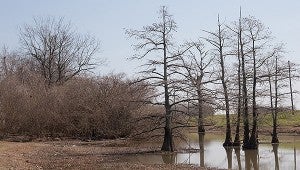Bald cypress: Signature trees of the South
Published 8:34 am Wednesday, February 5, 2014

Photo courtesy of www.SoutheasternFlora.com
BALD CYPRESS—The cone-shaped, sculptural forms of bald cypress trees in the winter landscape make them easy to identify
By Patricia Drackett
Director, Crosby Arboretum/ MSU Ext.
Can you spot a bald cypress tree in the winter landscape? Perhaps you have noticed the cypress trees that are growing in the median of Memorial Boulevard in Picayune, or know this tree because of its tendency to sprout “knees” in your lawn areas.
Bald cypress (Taxodium distichum) is a native tree that occurs naturally in wet habitats throughout the Coastal Plan, such as the pond edges of the Arboretum’s Aquatic Exhibit. It prefers acidic soils and full sun. But although it tolerates wet sites, the tree also does fine on upland environments, and is actually considered a drought-tolerant species!
According to the publication, “Champion Trees of Mississippi”, published by the Mississippi Forestry Commission, Mississippi’s largest tree is a bald cypress located near the town of Belzoni in Humphreys County on property owned by the Mississippi Department of Wildlife, Fisheries and Parks. The tree is 46 feet, 9 inches in circumference, about 15 feet in diameter, and 70 feet in height.
This state champion is found 300 feet from the former champion bald cypress, which is only slightly smaller and is the second largest tree in the state. According to the Champion Trees publication, one of these trees would produce enough lumber to build six ordinary houses!
This tree will grow quite tall, to 80 feet or more, but it will take quite a while to reach these heights.
Some specimens are known to be over 1,500 years old. Bald cypress grow quickly when young, and are attractive in the landscape due to their uniform shape and feathery leaves that turn a rusty orange in autumn.
The leaves may be raked from your turf areas and used to mulch your beds. If you don’t like the idea of knees sprouting in your lawn, consider planting a group of three or more cypress trees, and add some Southern blue flag iris at the base to create an “island” area in your lawn. The trees will provide you with a light and lacy shade.
Bald cypress is found planted in groupings around the Arboretum’s Piney Woods Pond. Do you have areas on your property that are constantly wet?
Observe how cypress is growing on our site and then repeat these patterns in your home landscape. Stand on the edge of our Pinecote Pavilion and look slightly to your left to the area called Cypress Head. Follow the Pond Journey to this area and you will discover an overlook surrounded by both bald cypress and pond cypress (Taxodium ascendens).
Pond cypress has a sparser, thinner look than bald cypress, and occurs naturally in wet savannas and shallow ponds, while bald cypress is found in much wetter areas such as swamps, floodplains, and bottomlands.
Would you like to come help us with a prescription burn for our grasslands, or savanna areas, at the Arboretum?
If you would like to be added to our list of burn crew volunteers to be called the morning of an event, contact Terry Johnson at 601-799-2311 Ext. 105.
If you only wish to observe, call the office around 9 a.m. on Thursdays and Fridays in February to see if arrangements are underway to apply for a burn permit.
Mark your calendar for the Crosby Arboretum Arbor Day Plant Sale on Saturday, February 15, from 10 a.m. to 3 p.m. (members enter one hour earlier). Site admission to the Arboretum, and the plant sale, will be free that day.
In addition, in celebration of Arbor Day we will be offering a free program to the public on the Gloster Arboretum on Saturday from 10 to 11 a.m. You are invited to hear site director Von Odenwald will talk about the history and development of this exception property located in Gloster, MS, managed by the John James Audubon Foundation.
Visit their website at www.glosterarboretum.com for more information, and you will see that this garden is well worth scheduling a day trip this spring to discover its treasures.
For more information, call the Crosby Arboretum office at (601) 799-2311 or visit our website at www.crosbyarboretum.msstate.edu.
The garden is open Wednesday through Sunday from 9 a.m. to 5 p.m. and located in Picayune, off I-59 Exit 4, at 370 Ridge Road (south of Walmart and adjacent to I-59).
FOR FURTHER EXPLORATION:
Would you like to learn more about Mississippi trees?
There is an abundance of information awaiting you on the Internet at the Mississippi Forestry Commission website.
You can visit the website of the Mississippi Forestry Commission at www.mfc.ms.gov. There you can read about Mississippi forest management, forest health, prescribed fire, and more.
Be sure to search the Internet for “Champion Trees of Mississippi” (MFC Publication #35). It is the official publication of the Mississippi Champion Tree Program, which is published by the Mississippi Forestry Commission.


